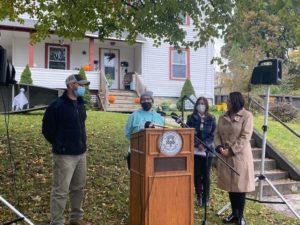Who is a member?
Our members are the local governments of Massachusetts and their elected and appointed leadership.

Officials provide an update about the At-Home in Pittsfield program on Oct. 27. Pictured (l-r) are Rehabilitation Specialist John Carchedi; resident Barbara Skalski, a program recipient; Housing Specialist Henide Harvender; and Mayor Linda Tyer. (Photo courtesy city of Pittsfield)
Building on the foundation of a popular initiative, Pittsfield is using federal COVID-19 recovery funds to expand access to an exterior home-renovation program that helps to boost neighborhood property values and quality of life.
In April, the city launched At-Home in Pittsfield, a loan program giving residents up to $25,000 apiece to repair their homes’ exteriors. Pittsfield used $500,000 from the city’s economic development fund to cover the loans, and by the fall, it had used almost $421,000 to help 19 homeowners. Officials are now preparing to add another $500,000 with funds from the American Rescue Plan Act.
“We feel very strongly that this is absolutely part of a comprehensive strategy to build an economy,” said Mayor Linda Tyer. “When you have neighborhoods filled with houses that have value, that’s good for the economy.”
The At-Home program helps fund various home exterior projects, including roof replacements, new windows and doors, porch repairs, chimney repairs, and siding replacement, said Deanna Ruffer, Pittsfield’s community development director. Loans average about $20,000.
The city will forgive loans for people who remain in their homes for at least seven years afterward, while those who move earlier must pay back loans on a prorated basis. Pittsfield is working with several local banks to provide the loans.
Pittsfield also provides recipients with a list of qualified contractors, from which homeowners must get three quotes. The city had engaged several of the contractors in training to qualify them for aspects of the work, including deleading.
To qualify, homeowners must occupy their houses and must have owned them for at least two years. The homes cannot have more than two units. The city is targeting 60% of the funds for two urban neighborhoods, Ruffer said. Program materials and applications are made available in English and Spanish.
Of the 19 homeowners approved so far, Ruffer said, four were elderly, 12 were female-headed households, and 21% were Hispanic or Black. According to Tyer, the program helps people who don’t have access to banks or financial planning.
“This is a way to improve quality of life in the neighborhoods and to help some of our low-to-moderate income residents build equity, and close that wealth gap that some of our residents are currently experiencing,” Tyer said.
To include more moderate-income homeowners, Pittsfield set the income limit at 120% of area median income, unlike other programs with lower limits, Tyer said.
Housing Specialist Henide Harvender and Rehabilitation Specialist John Carchedi have helped homeowners navigate the process — from understanding application requirements and project eligibility to analyzing contractors’ bids.
“It was really beneficial to the homeowners for our rehab specialists to spend as much time as they have with each homeowner,” Ruffer said.
The staff has also sought alternatives for applicants who didn’t qualify for the program. In several cases, the city directed homeowners to programs such as Community Development Block Grants. In addition, homeowners could explore whether home equity loans or refinancing could help pay for their renovations.
Demand for the program has outpaced availability, with the city having received more than 80 applications in a few months. For that reason, Pittsfield plans to use $500,000 from its first round of ARPA funding for the At-Home program, and then another $500,000 when it receives its second round.
Through this program, Ruffer said, Pittsfield developed new paperwork that could be helpful for other communities. Tyer said she hopes Pittsfield’s model will inspire the state to devote funding for similar efforts, so other communities can benefit from this type of investment.